
The response rate of cold emails is greater than what you think. Research shows that the average response rate of targeted cold emails is 15.22-28.46% (note that we’ve highlighted the word “targeted”).
But, let’s face it. A cold email campaign is like door-to-door marketing. Somedays, you’ll only end up with zero replies. Creating cold emails is easier said than done, and most emails simply don’t work. But wait, did you know that cold emails (if done right) can set you far apart from mediocrity? Have a look at why you must include cold email outreach in your recruitment strategy.
Potential Benefits of Cold Recruitment Emails
- You can reach people where they spend most of their time.
- Especially, most employees check their inboxes every day, so there are high chances of your email getting noticed and read.
- You can send out as many emails a day and pitch creatively, which is sometimes not possible on calls.
- Cold emails are an excellent way to reach out to passive candidates.
- You can reach out to candidates in the best times your prospects are active online, even after 8 PM.
Now, you may be wondering should I send cold emails to candidates? And, our answer is a loud YES. Creating cold emails might be tricky, but it’s not undoable. And luckily, we’ve curated a simple and effective guide to creating effective cold emails for recruiting. We’ll discuss how to create memorable recruiting cold emails that convert candidates and drive a higher reply rate.
10 Amazing Cold Recruiting Email Tips and Templates
1. Target the Right Candidates
The success of your cold email campaign significantly depends on your target audience. There’s no surprise you’re going to fail if you’re sending emails to the email addresses which are not relevant.
Sourcing emails should be sent to a carefully curated list of candidates. Targeting only the potential candidates saves you a lot of time and allows you to create the best sourcing email templates.
After you’re ready with the target audience list, ensure to warm up them before shooting recruitment emails. Try to engage with them on LinkedIn through comments or customized ads. Doing so makes the cold leads warmer and increases the chances of email getting noticed.
2. Create Compelling Subject Lines
Everybody knows this- subject lines play a vital role in any email campaign. Subject lines should be short, sweet, and compelling to attract recipients to open the emails—about 35% of recipients open emails based on the subject line. Keeping the length of the subject line under 45 characters, you can expect an open rate of 33%, and when you use 3-12 characters, you can expect a 44% open rate.
To make subject lines even more impressive, add a dash of personalization. Using their name, location, or job title in the subject lines can significantly impact the open rate. For this, do enough research to find out if the candidate matches the job profile firstly. Secondly, note down the candidate’s skills, qualifications, past work experience, current job title, career goals so that you can directly get to the point and save time if the information is relevant to the job role.
You can also include the referee’s or shared connection’s name in the subject line to show them that there is a connection between you already. Most importantly, avoid spammy words like RE: Action Required, and using all CAPS can drop your email in the spam folder.
Some of the best examples for cold email subject lines for recruiters:
- New Growth Hacker Opportunity.
- <FirstName>, Let’s talk about your career goals.
- We think it’s time for a career boost!
- Your dream job is waiting for you.
- <FirstName>, New Software Developer Opportunity in Austin!
- An invitation to <FirstName> for (Job Title).
- Just got off the phone with (Connection).
3. Create a Personalized and Relevant Message.
Most cold emails are generated automatically. And this is why they have a terrible reputation.
As we discussed in the above point, doing enough research helps you curate a personalized message. You can use their company name, location, job role while conveying your message. Bring out common interests or their tastes and talk about them. This helps the recipients understand your effort in knowing them. But remember, don’t sound too creepy.
When you can show them that you know well about the candidate’s background and have acknowledged it, they develop a positive impression of you. Hence they may at least leave a one-line reply for you.
Don’t make your cold email campaign even harder with automated sourcing emails. Make an impression by sending a personalized and relevant message. These cold recruitment email templates will help you understand better.
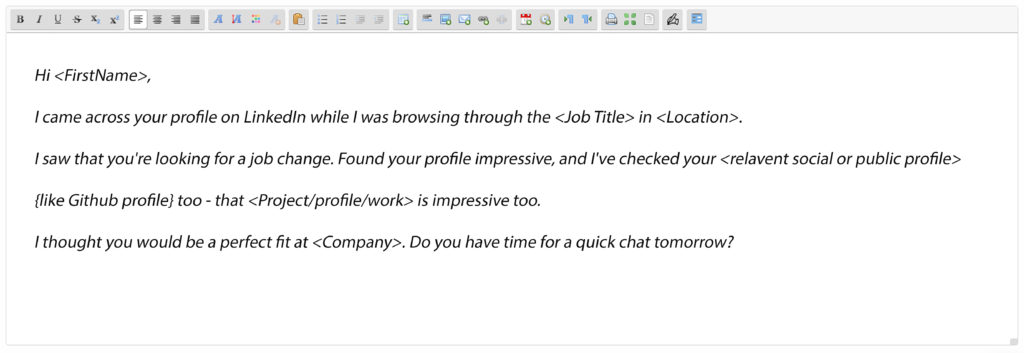
Cold Email Templates for Passive Candidates
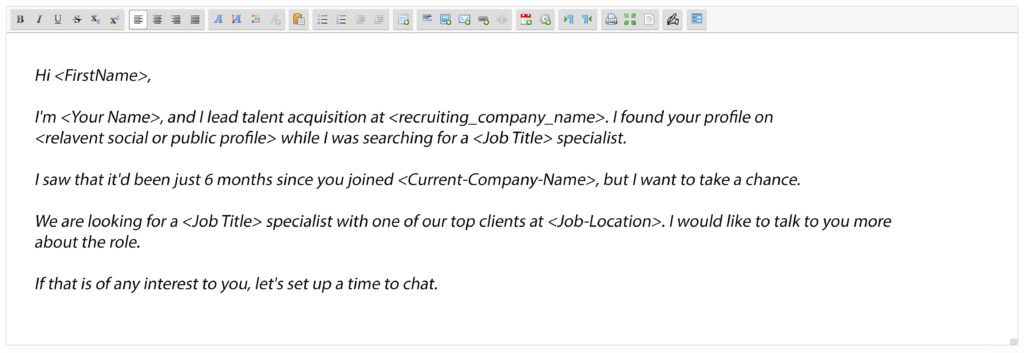
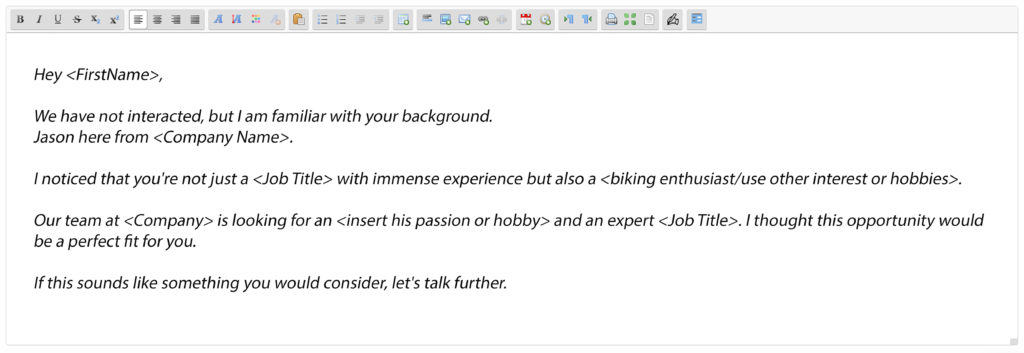
4. Check If your Tone Reflects your Brand
When sending out recruitment emails to candidates, make sure you maintain consistency with your brand’s voice.
Say, if yours is a well-established traditional company, you can address the candidate- “Dear Mr. Mark,” Or if yours is a modern start-up company looking for millennials, you can use “Hey Jason.” Even the greeting makes a difference. Of course, the entire email should be in the same tone. Make sure you use the same tone you’ve used for your brand everywhere else, such as company website, social media, and the workplace.
5. Don’t Waste Their Time
Don’t forget the purpose of a cold recruitment email. You need to drive candidates to open the email first and then contact you. However, you should not forget that your prospects are busy with many works. Keep your email simple. Don’t explain what your company does, when did it start and who started it. If you do so, your email will only enter the trash bin.
Instead, tell them why did you email and what’s in it for them. Tell them the benefits of joining your company and how it adds value to their career. Your subject line, message, and signature should be simple, short, and easy to understand. Let’s see how to do it in the next point.
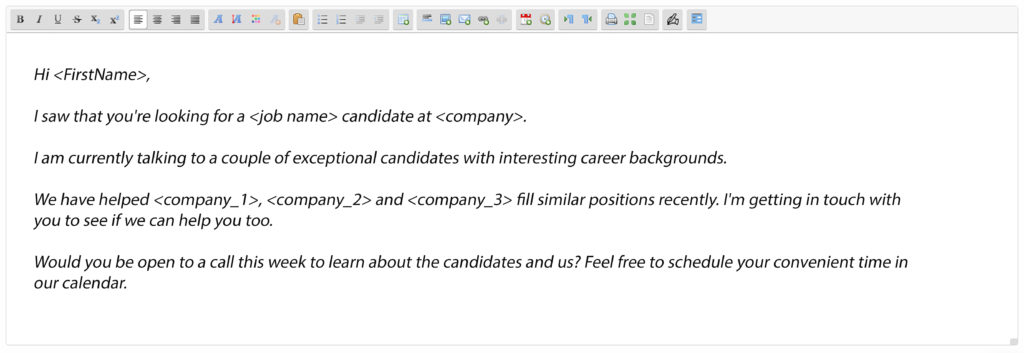
6. Keep it Brief, Simple, and Clear
We get it. You want to provide complete information about your company when you’re sending an email. But doing so, you risk losing their interest. Nobody wants to read paragraphs of history in their email inbox. So, keep your message short and to the point. Instead of bragging about your company, tell them what you can do for them. This shows that you value their time. You can always provide a link to your website careers page or LinkedIn page below your message.
The other important tip you need to remember is don’t complicate your message using fancy or jargon words. Instead, use plain and straightforward language that anybody can read and understand at a glance.
Here are simple candidate email templates:
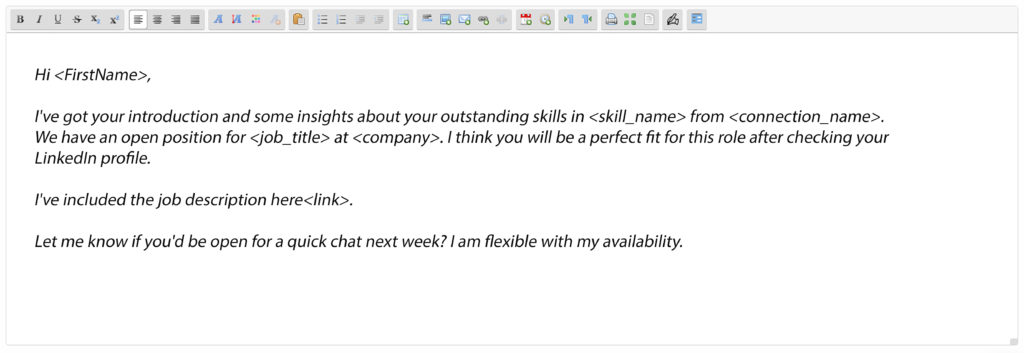
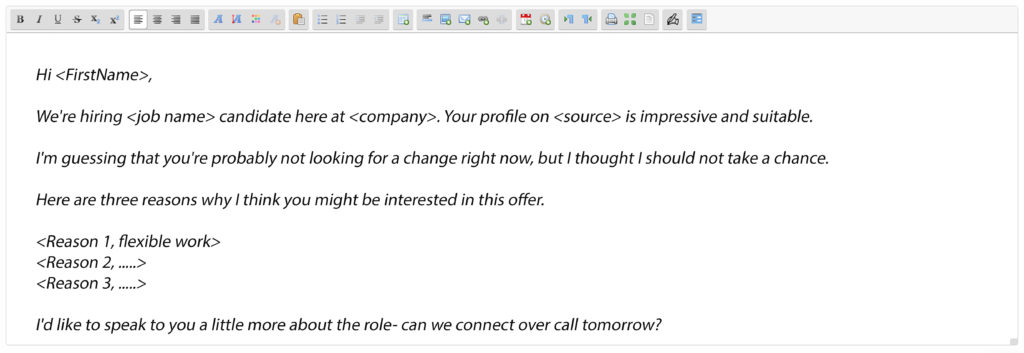
7. Don’t Forget the CTA
As we said, the ultimate goal of the cold recruiting emails is to convince the candidates to connect over the call or meet. It is your call to action. So, don’t forget to include the CTA in your recruiting email template. Also, keep the CTA as simple as possible. Feel free to ask them their convenient time or confirm the scheduled time or schedule time on your calendar to connect.
Here are some examples:
- What’s the best way for us to connect?
- Are you open to chat?
- Would you like to learn more?
- Shall we grab coffee next week to chat?
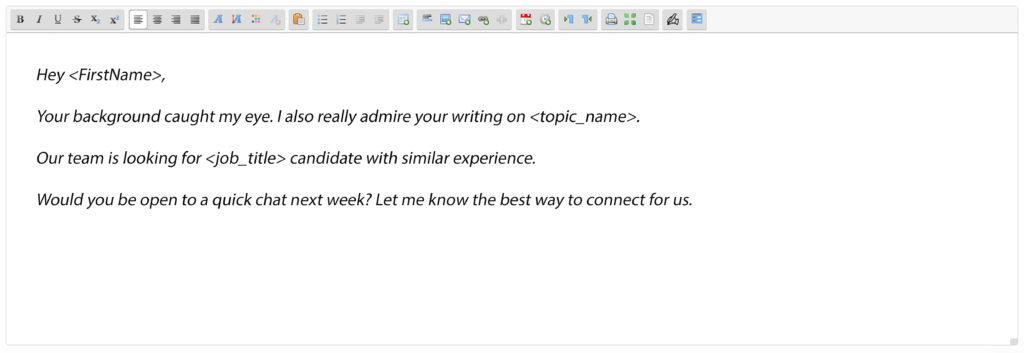
8. Keep the Signature Short & Sweet
Most often, recruiters keep the signature section nearly the same or twice the size of the email, adding unnecessary logos, awards, and links and make the page look clumsy. Of course, a signature is an essential element in the email, but that doesn’t mean you have to include every detail that made you proud.
Keep it utmost simple by including your name and job title. This makes the recipient feel the email is personal rather than a pitch. You can include essential and relevant lines about the company or a link such as your LinkedIn profile or about us page in your signature.
Additionally, adding a postscript (P.S.) can make a positive impact. People read P.S. the most and remember it. So, make the most of your signature by including a P.S. if you have a takeaway point to offer for the candidates.
Example:
Regards,
Mark Rogers
Head of Recruitment @ <company>
A fortune 500 company
9. The Magical Step is Follow Up
Now comes the most vital part (and the magical part) of the cold recruiting emails campaign. Follow up. Most recruiters wonder why their emails failed. It is because you didn’t follow up, or your follow-up looked like this.
Hey {{FirstName}},
Just following up to know if the below email is of any interest to you.
A follow-up email is to direct readers’ attention to the previous email so that they read it and respond to the follow-up email. You can’t simply poke them and remind your last email in a single line like the above one. Neither should you repeat what your first email says. Instead, refer to the previous touchpoint and add some more important details of your company to it.
Examples:
- I have tried to contact you last week but haven’t heard from you yet.
- Considering your recent <achievement>, would you like to take on the new challenge with us?
- Do you have 15 minutes to talk about the opportunity we discussed in the previous email?
The other fantastic tip is- make it easy for recipients to respond to your follow-up email. Have a look at the below recruiting cold email template:
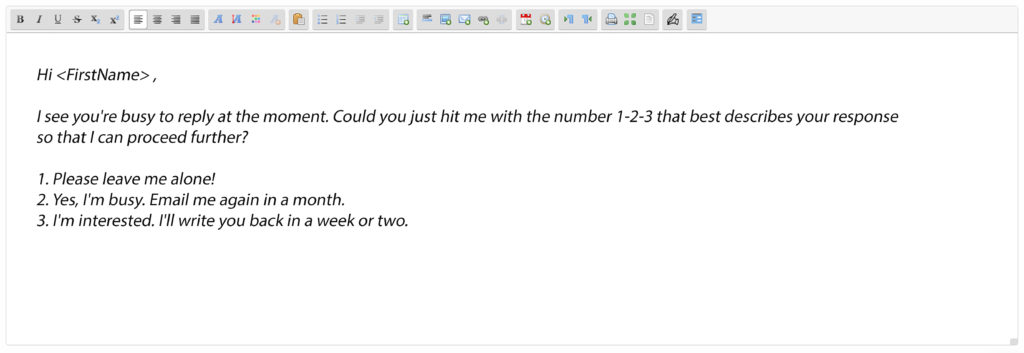
These responses are both funny and straightforward; these at least make recipients respond.
Bonus Tip: Make sure you send follow-up emails in the same thread as previous emails. This increases responses as it saves time for candidates, and you will also have a complete record of emails in one place
10. The Best Template Doesn’t Sound like a Template.
The purpose of a cold email is primarily to get a response so you can grab the phone and talk to that candidate. However, remember that getting a response is not easier. Your prospects receive hundreds of emails every day. The chances of reading your email are meager unless the email stands out.
Imagine your prospects noticing that your email is similar to other emails in their inbox. So, by no way, your email template should sound like the other emails. Your email should not look like that of your competitors’ sourcing emails and also like a template.
The best thing you can do is take references from different templates and create your own template. This should help you stand out from the rest.
Other Cold Recruiting Email Tips for Recruiters
Get candidates to respond to your cold emails with these bonus tips:
- Stay in touch with your prospects across multiple channels and build a connection before you email them.
- Provide reasons for your prospects to read the email.
- Analyze your email campaign. Find out the best day, the best time to send sourcing emails by analyzing open rate metrics.
- Take advantage of visuals. Make your email is interactive and engaging using funny images and memes.
- Don’t make it complicated to read using fancy words. Be clear, concise, and friendly.
- Customization and personalization are the keys. We repeat it.
- Lastly, don’t forget to stand out. Do not copy. Create and have your own recruiting email templates.
- Always experiment with your subject line and body to see what works for you. Conduct an A/B test for your subject lines alone or the entire template to find the ideal one for you.
Create An Effective Recruiting Cold Email Template
If you’re thinking about how to create your own cold email template, you should just start writing. Don’t wait for motivation from somewhere to step up your recruitment strategy and include cold emails in it. Takeaway our tips and start creating a recruiting template on your own. You can also use our email templates but don’t forget to add your style before sending them to the candidates.
To receive and stay updated about related content:





